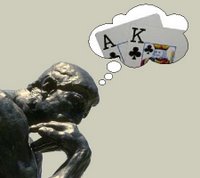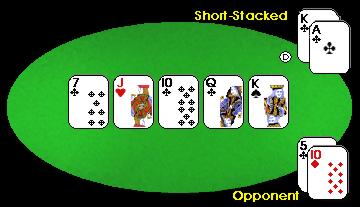 Had a goofy hand yesterday swimming with the fishes in a game of $0.50/$1.00 6-handed limit over on Party. The kind of thing one sees fairly regularly in that particular aquarium, actually. The hand itself doesn’t have a lot to offer in terms of life lessons, but it did get me thinking a bit about how certain players -- chiefly inexperienced ones -- tend to interpret preflop raises in limit.
Had a goofy hand yesterday swimming with the fishes in a game of $0.50/$1.00 6-handed limit over on Party. The kind of thing one sees fairly regularly in that particular aquarium, actually. The hand itself doesn’t have a lot to offer in terms of life lessons, but it did get me thinking a bit about how certain players -- chiefly inexperienced ones -- tend to interpret preflop raises in limit.We had two empty seats at the time, actually, so there were only four of us for this particular hand. I was on the button where I was dealt Ac Kc. UTG folded, I raised, the SB folded, and the BB called. So far so what. The flop comes 7c Jh Tc and the SB open bets. Looking at the nut flush draw, a gutshot draw, and two overcards (a whopping 18 outs, potentially), I decide to raise. The SB reraises, quickly erasing from my mind the 4 outs represented by the non-club aces or kings. Still, I figure I’m close to 50-50 here even if my friend has 98 and has flopped a straight, and so I decide to cap it. (Checking later on CardPlayer’s Texas Hold ‘em Calculator, I see I’m 47% to win if my opponent indeed has 98 and no clubs.)
I’ll make this play occasionally with a strong draw and position with the hope of misleading my opponent into thinking I already have a made hand and am protecting. The SB calls, of course, and there is $6.25 in the pot when the Qc charmingly falls on the turn, giving me my nut flush.
My initial response to seeing the queen was mixed. After all, if my opponent only has a pair (the most likely hand), the queen should scare him or her away. My mood changed quickly, however, when my opponent again open bet. Must really have the 98, I think gleefully as I raise, am reraised, and then cap again. The pot is up to $14.25 when the river brings the Ks. Finally my opponent slows down and checks. I bet, s/he calls, and I collared $15.50 (minus the rake), netting 7.5 BB all told.
What did my opponent have? 10d 5c. I jive you not. Either s/he was completely wet behind the ears (a definite possibility), or perhaps believed on the turn that even if those crummy tens were no longer good there was the possibility of a fourth club and a hand-winning flush on the river. Hey, it could happen. And NBA refs’ll start calling travelling once we get to the finals.

The hand made me think of how when I first started playing limit I would routinely put preflop raisers on AK. Only after a few months of disillusionment did I realize how damaging to one’s stack such reflexive “putting-on-a-hand” can be. The Big Slick Assumption is directly consequent to wishful thinking about one’s pocket pair or the pair one flops after calling the preraise. You’ve seen it, I know. It’s heads-up after the preraise, the board shows no A or K, and the preflop caller commences to duel with the raiser. As I said, I’ve been guilty, too (though hopefully less often now than when I first began playing).
The hand seemed remarkable to me precisely because my opponent appeared not to have made the Big Slick Assumption (acting utterly unfazed with QJT on board). Perhaps s/he has yet even to reach that stage of development as a player, not yet ready to make reads or assumptions at all. In any event, while the hand itself was hardly special, it did remind me of at least two truths for microlimit play: (1) When you’ve hit your hand, bet bet bet (avoid slow-playing, check-raising, or other examples of “Fancy Play Syndrome” as Mike Caro puts it). (2) Don’t let the Big Slick Assumption talk you into thinking your bottom pair is going to be enough to beat the preflop raiser. Especially if he raises you on the turn.
No comments:
Post a Comment